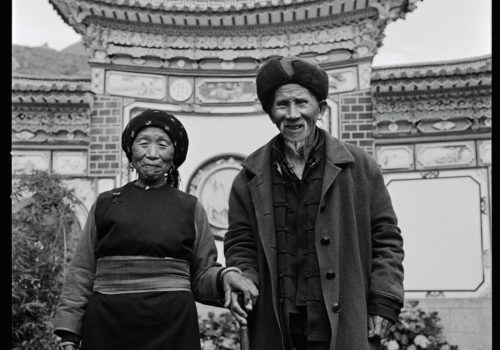Dali Prefecture is the former capital of the Nanzhao Kingdom (8th-9th century) and the Buddhist Dali Kingdom (AD 937-1253). With a population of 3.6 Million inhabitants, 30% of Bai ethnic minority and situated at 1,800 m above sea level, Dali is one of the main tourist destinations in Yunnan Province, halfway between Kunming and Lijiang. Dali is also famous for its marble quarry hence the word for marble in Chinese is “Dali stone”.
2009 was the year when the Dali international photography festival was created, which will become a biennial from 2015 onward. In November 2014, in a former factory for bed sheets, the Dali Photography Museum opened its door with a roundtable gathering photographers, collectors and curators, to discuss the sustainability of the Museum in the areas of exhibitions and the creation of a photographic archive. The Museum’s priority lies in the collection of old photographs of Dali in the early 20th century, made by Western photographers and missionaries, also of contemporary photography by local and foreign photographers. The embryonic collection includes prints from a photographic residency project carried out in 2012, which was exhibited at the 5th Dali Photo Festival in 2013. The “East-West Dali” project gives carte blanche to six Chinese photographers (including one from Taiwan) and five Western photographers who have taken up a ten-day residency in Dali, working according to their own style, their cultural sensitivity and centers of interest. This clash of styles and approaches to the same subject (the city of Dali) allow the public and photo lovers to appreciate the multi-facets of contemporary photography and to discover the scope of Dali’s human, historical and cultural assets, and its landscapes ranging from the city to the mountains, forests, lakes and rivers.
An GE, documentary photographer from Canton, author of several books on the Deng Xiaoping era, worked on the theme of time passing in Black and White LIN Tianfu, a Taiwanese photographer, focused on his long-term work: portrait of old couples who have been married for over 50 years, mostly among the ethnic minorities of China. LU Yuanmin, the humanist photographer of Shanghai, brings his humor and high contrast grainy B & W photography of street scenes. WEI Bi, freelance photographer from Hunan, presents his vision of Dali in the tradition of classical painting. XIAO Quan, photographer from Chengdu and renowned portraitist, former assistant of Marc Riboud, reveals the little-known intimate face of the celebrated dancer and choreographer Yang Liping, at her home on the shore of Erhai Lake in Dali. CHEN Zhe, native of Beijing who now lives in California, winner of the Inge Morath Award, uses Dali as the first chapter of a psychological self-analytical new work, through her very personal and atmospheric vision.
From the Western point of view, three Frenchmen came with their individual approach: Thierry Girard examines urban and rural transformations that have been affecting all regions of China. Yann Layma a China veteran looks at Dali’s spirituality behind his series of apparent postcards. Patrick Zachmann is interested in the relationship between youngsters and their parents or grandparents in his TransGeneration series. Lois Conner, the American photographer well-known for her panoramic platinotypes has discovered Van Gogh’s soul in the fields and marble quarry of Dal. Finally Anna Kahn, a Brazilian woman photographer, presents a contemplative work on memory inspired by Gaston Bachelard’s texts in “Water and Dreams”.
INFORMATIONS
Dali Photography Museum
56 Cangping street
Old City
Dali, Yunnan
China
www.dali.photo (available soon)
















